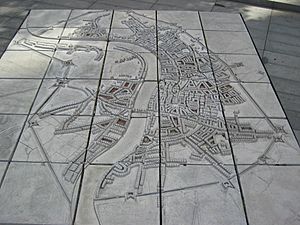Lines of Communication (London) facts for kids
The Lines of Communication were a massive set of defenses built around London during the English Civil War. These fortifications were ordered by Parliament in 1643. Their main purpose was to protect London, the capital city, from attacks by the Royalist armies of King Charles I.
Before these big defenses, London had older Roman and medieval walls around its central area. The Lines of Communication were built to add extra protection beyond these older walls.
In 1642, some simple defenses like street barricades and small earth mounds were put up. But in 1643, a much bigger effort began. A complete ring of strong defenses was built all around the city.
Many people helped build these lines. Up to 20,000 volunteers worked on them! They were organized by local groups like the trained bands (citizen soldiers) and livery companies (trade guilds). Amazingly, these huge defenses were finished in less than two months.
However, the fortifications were only tested once. In 1647, the New Model Army entered London without a fight. The defenses were then taken down by Parliament that same year.
Contents
Building London's Defenses
These defenses were mainly a strong earthen wall, called a rampart. This wall was supported by 23 different forts and strong points. They circled the entire city, including areas like Southwark, about one to two miles from the city center.
A map from 1738 by George Vertue shows how the line stretched. It started near the Tower of London by the Thames River. Then it went north towards Whitechapel Road. It turned northwest, crossing areas like Hackney and Kingsland Road near Shoreditch.
The line then turned southwest, crossing St. John Street, Gray's Inn Lane, Bloomsbury, and New Oxford Street. It continued west to Hyde Park Corner and Constitution Hill. From there, it moved towards Chelsea Turnpike, Tothill Fields, and back to the Thames.
On the south side of the Thames, the defenses started near Vauxhall. They ran northeast to St. George's Fields. Then they turned east, crossing Borough Road and Tabard Street. Finally, they joined the Thames again, almost opposite where they began.
Key Fortifications Around London
The main forts and strong points were placed around the city in a large circle. Here are some of the important ones, moving counter-clockwise from the northeast side of the Thames:
East Side Defenses
- A bulwark (a strong part of a wall) and half-bulwark at Gravel Lane.
- A Hornwork (a type of outer defense) on Whitechapel Road.
- A Redoubt (a small, enclosed fort) with two flanks (side defenses) at Brick Lane.
- Another redoubt with four flanks on Hackney Road.
- A redoubt with four flanks on Kingsland Road.
North Side Defenses
- A battery (place for cannons) and a breastwork (low wall) at Mountmill.
- Another battery and breastwork on St John Street.
- A small redoubt on Islington Road (this was a bit further out).
- A large Fort with four half-bulwarks near the Upper Pond of the New River (also an outer defense).
- A battery and breastwork on a hill near Black Mary's Hole.
West Side Defenses
- Two batteries and breastworks near Bedford House.
- A redoubt with two flanks on St Giles Road.
- A small fort on Tiburn Road.
- A large fort with four half-bulwarks on Wardour Street.
- A small bulwark at Olivers Mount.
- A large fort with four bulwarks at Hyde Park Corner.
- A small bulwark and battery on Constitution Hill.
- A Court of Guards (a guard post) at Chelsea Turnpike.
- A battery and breastwork at Tothill Field.
South of the Thames Defenses
- A Quadrant Fort (a fort shaped like a quarter circle) with four half-bulwarks at Vauxhall.
- A fort with four half-bulwarks at St George Field.
- A large fort with four bulwarks on Blackman Street.
- A redoubt with four flanks on Kent Street.



